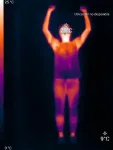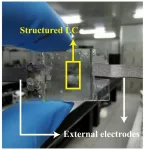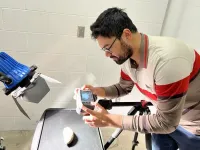(Press-News.org) WASHINGTON — Researchers have developed a new method that combines video from thermal cameras with AI-based digital processing to enhance weightlifting training. By providing data-driven insights that enable targeted training and recovery strategies, the approach could help to optimize performance and safety in a variety of sport and exercise contexts.
Thermal, or infrared, images can provide valuable information for sports and health by tracking muscle activation and detecting areas of strain or fatigue. This information can be used to prevent injuries, monitor thermal responses and quantify physical exercise, ultimately helping athletes boost their skills. However, most current methods use before-and-after snapshots, offering only a limited view of the complex dynamics happening inside the body.
“We developed an approach that analyzes a complete thermal video recording while automatically obtaining the relevant parameters,” said research team leader Laura Viafora from Universidad de Concepción in Chile. “By analyzing the entire movement continuously, rather than just specific moments, we can track the progression of temperature variation in real-time and understand what happens throughout the entire exercise.”
In the Optica Publishing Group journal Applied Optics, the researchers show that the new method can be used to monitor muscle exertion during weightlifting using images from either an inexpensive thermal camera attached to a smartphone or a high-end thermal device, providing flexibility and accessibility for different training needs.
“Our goal is to continue developing this concept so that it can be used by athletes and coaches,” said Viafora. “We also aim to refine this technology for applications in the healthcare field by providing specialists with thermal data and information body position, which could contribute to more effective rehabilitation after an illness or injury.”
Turning images into insights
For a sport like weightlifting, athletes and coaches can get a lot of useful information from tracking small changes in temperature and body positioning throughout an exercise. To accomplish this, the researchers developed data processing algorithms and then used Google MediaPipe artificial intelligence software to identify individuals and their body parts within the images and extract the required information.
To obtain temperature data, the researchers identified the body part of interest and then converted the pixel color information into temperature values. For positional information, key points in the joints were identified and used to calculate the corresponding angles. Finally, to study the barbell’s movement, they detected the weight plates in the scene and then recorded the locations of their central points in each frame. Repeating this process for all frames allowed the researchers to produce graphs and frame-by-frame images tracking positional and temperature changes throughout the exercise.
To test the new method, they recorded athletes using a low-end thermal camera attached to a smartphone, a high-end stand-alone thermal camera and a conventional camera. This approach allowed them to compare results using various cameras and evaluate the effectiveness of body detection and angle estimation. The videos acquired with the various cameras were all uploaded to a computer for analysis.
These initial tests showed positive results, demonstrating that the new method could be used to generate a color-labeled sequence of thermal images from multiple camera types as well as reports on body part positions, which could be helpful for guiding athletes toward safer and more efficient practices.
Optimizing detection
The different camera types did come with some limitations. For example, both types of thermal cameras performed well at distinguishing the athlete’s body from the background, but this was found to be more complicated with a conventional camera. The quality of the thermal camera also influenced preliminary detection, highlighting the importance of selecting equipment that matches the level of precision needed. Some movements were also difficult to detect such as when the athlete was curled up or a weight obscured the body.
“Using thermal images to analyze the entire movement continuously allows us to obtain not only positional data throughout the exercise but also information about body temperature,” said Viafora. “We can see whether one side of the body is being exerted more than the other, and thermal images make it easier to identify individuals compared to conventional images, which can be influenced by background colors, clothing and skin tone.”
Now that they have demonstrated the feasibility of this approach, the researchers would like to use the method to analyze images of athletes from various disciplines, including conventional and paralympic sports. They are also working to refine their algorithm so that it can provide actionable information to users. For example, if an athlete raises their arm, the system could provide real-time feedback on whether the movement was performed correctly.
Paper: L. A. Viafora, S. N. Torres, G. Machuca, P. Gutierrez, A. Jara, P. Coelho, R. F. Soto, “An infrared imaging technique for weightlifting exercise assessment,” Applied Optics, 63, 28, 7529 (2024).
DOI: https://doi.org/10.1364/AO.532763
About Optica Publishing Group
Optica Publishing Group is a division of the society, Optica, Advancing Optics and Photonics Worldwide. It publishes the largest collection of peer-reviewed and most-cited content in optics and photonics, including 18 prestigious journals, the society’s flagship member magazine, and papers and videos from more than 835 conferences. With over 400,000 journal articles, conference papers and videos to search, discover and access, our publications portfolio represents the full range of research in the field from around the globe.
About Applied Optics
Applied Optics publishes in-depth peer-reviewed content about applications-centered research in optics. These articles cover research in optical technology, photonics, lasers, information processing, sensing, and environmental optics. Optica Publishing Group publishes Applied Optics three times per month and oversees Editor-in-Chief Gisele Bennett, MEPSS LLC. For more information, visit Applied Optics.
Media Contact
mediarelations@optica.org
END
Combining AI and thermal video offers a new window into weightlifting
Technique unlocks key data for enhancing performance and preventing injury in sports, physical therapy and rehabilitation
2024-09-30
ELSE PRESS RELEASES FROM THIS DATE:
Childhood social interactions combat stereotypes
2024-09-30
Prior research has found that exposure to social diversity in early life, such as through day care, influences how people communicate.
Those early social experiences can also moderate tendencies toward stereotyping down the road, according to a new study published in the NPJ Science of Learning.
"The more time an individual spent in day care as a child, the more likely they are to overcome their own stereotypical beliefs during social interactions later in life," says senior author Arjen Stolk, an assistant professor in the Department ...
Researchers harness liquid crystal structures to design simple, yet versatile bifocal lenses
2024-09-30
WASHINGTON — Researchers have developed a new type of bifocal lens that offers a simple way to achieve two foci (or spots) with intensities that can be adjusted by applying external voltage. The lenses, which use two layers of liquid crystal structures, could be useful for various applications such as optical interconnections, biological imaging, augmented/virtual reality devices and optical computing.
“Most liquid-crystal-based devices are made from single-layer structures, but this limits light field modulation ...
Suicide attempts decreased after adding suicide care to primary care, study finds
2024-09-30
After suicide care was integrated into routine primary care visits, researchers saw a 25% decrease in the rate of suicide attempts in the following 90 days, a new Kaiser Permanente study finds.
The study, published in the Annals of Internal Medicine, is the first to show that suicide risk screening in primary care, followed by safety planning, improved suicide prevention efforts in a health care setting. The trial took place at Kaiser Permanente clinics in Washington state, using data from January 2015 to July 2018.
“Our findings are important because we know many people seek primary care prior to fatal and nonfatal suicide attempts,” ...
One in three Americans has a dysfunctional metabolism, but intermittent fasting could help
2024-09-30
LA JOLLA (Sept 30, 2024)—More than one-third of adults in the United States have metabolic syndrome, a cluster of conditions that significantly raise a person’s risk of heart disease, stroke, and type 2 diabetes. These conditions include high blood pressure, elevated blood sugar, excess abdominal fat, and abnormal cholesterol levels.
In a new clinical trial, researchers at the Salk Institute and University of California San Diego School of Medicine found that time-restricted eating—also known as intermittent fasting—could offer significant health benefits to adults with metabolic syndrome. Patients ...
Time-restricted eating associated with greater blood sugar control and fat loss than standard nutrition counseling
2024-09-30
Embargoed for release until 5:00 p.m. ET on Monday 30 September 2024
@Annalsofim
Below please find summaries of new articles that will be published in the next issue of Annals of Internal Medicine. The summaries are not intended to substitute for the full articles as a source of information. This information is under strict embargo and by taking it into possession, media representatives are committing to the terms of the embargo not only on their own behalf, but also on behalf of ...
New imaging technique brings us closer to simplified, low-cost agricultural quality assessment
2024-09-30
URBANA, Ill. – Hyperspectral imaging is a useful technique for analyzing the chemical composition of food and agricultural products. However, it is a costly and complicated procedure, which limits its practical application. A team of University of Illinois Urbana-Champaign researchers has developed a method to reconstruct hyperspectral images from standard RGB images using deep machine learning. This technique can greatly simplify the analytical process and potentially revolutionize product assessment in the agricultural industry.
“Hyperspectral ...
Purdue-led TOMI project receives $3.5M grant to turn a decade of data into new tools and strategies for tomato farmers
2024-09-30
Purdue-led TOMI project receives $3.5M grant to turn a decade of data into new tools and strategies for tomato farmers
WEST LAFAYETTE, Ind. — Indiana ranks third in the nation for tomato production. Lori Hoagland, a professor in Purdue University’s Department of Horticulture and Landscape Architecture, recently received a third grant from the U.S. Department of Agriculture’s National Institute of Food and Agriculture (USDA-NIFA) for the Tomato Organic Management and ...
Could a bout of COVID protect you from a severe case of flu?
2024-09-30
More than 200 viruses can infect and cause disease in humans; most of us will be infected by several over the course of a lifetime. Does an encounter with one virus influence how your immune system responds to a different one? If so, how? Does it weaken your defenses, boost them, or have some other impact altogether?
These are questions Rockefeller University scientists from the Laboratory of Virology and Infectious Disease,headed by Charles M. Rice, and Weill Cornell Medicine’s Laboratory of Epigenetics and Immunity, headed by Steven Z. Josefowicz, teamed up to answer in a new study published in the journal Immunity. ...
When detecting depression, the eyes have it
2024-09-30
Hoboken, N.J., September 30, 2024 – It has been estimated that nearly 300 million people, or about 4% of the global population, are afflicted by some form of depression. But detecting it can be difficult, particularly when those affected don’t (or won't) report negative feelings to friends, family or clinicians.
Now Stevens professor Sang Won Bae is working on several AI-powered smartphone applications and systems that could non-invasively warn us, and others, that we may be becoming depressed.
“Depression is a major challenge,” says Bae. “We want to help.”
"And since most people in the world today use smartphones daily, this could ...
NRG Oncology trial implies the addition of atezolizumab concurrently to standard of care does not improve survival in limited-stage small cell lung cancer
2024-09-30
The addition of the cancer immunotherapy drug atezolizumab to the standard of care concurrent chemoradiation (cCRT) did not improve overall survival for patients with limited-stage small cell lung cancer (LS-SCLC) in the second planned interim analysis of the NRG Oncology/Alliance NRG-LU005 clinical trial. These results were recently reported during the Plenary Session of the American Society for Radiation Oncology Annual Meeting in Washington, DC.
“While atezolizumab given concurrently with chemoradiation did not improve survival, we have still learned quite a bit from these findings. With the success of the ADRIATIC trial ...
LAST 30 PRESS RELEASES:
Numbers in our sights affect how we perceive space
SIMJ announces global collaborative book project in commemoration of its 75th anniversary
Air pollution exposure and birth weight
Obstructive sleep apnea risk and mental health conditions among older adults
How talking slows eye movements behind the wheel
The Ceramic Society of Japan’s Oxoate Ceramics Research Association launches new international book project
Heart-brain connection: international study reveals the role of the vagus nerve in keeping the heart young
Researchers identify Rb1 as a predictive biomarker for a new therapeutic strategy in some breast cancers
Survey reveals ethical gaps slowing AI adoption in pediatric surgery
Stimulant ADHD medications work differently than thought
AI overestimates how smart people are, according to HSE economists
HSE researchers create genome-wide map of quadruplexes
Scientists boost cell "powerhouses" to burn more calories
Automatic label checking: The missing step in making reliable medical AI
Low daily alcohol intake linked to 50% heightened mouth cancer risk in India
American Meteorological Society announces Rick Spinrad as 2026 President-Elect
Biomass-based carbon capture spotlighted in newly released global climate webinar recording
Illuminating invisible nano pollutants: advanced bioimaging tracks the full journey of emerging nanoscale contaminants in living systems
How does age affect recovery from spinal cord injury?
Novel AI tool offers prognosis for patients with head and neck cancer
Fathers’ microplastic exposure tied to their children’s metabolic problems
Research validates laboratory model for studying high-grade serous ovarian cancer
SIR 2026 delivers transformative breakthroughs in minimally invasive medicine to improve patient care
Stem Cell Reports most downloaded papers of 2025 highlight the breadth and impact of stem cell research
Oxford-led study estimates NHS spends around 3% of its primary and secondary care budget on the health impacts of heat and cold in England
A researcher’s long quest leads to a smart composite breakthrough
Urban wild bees act as “microbial sensors” of city health.
New study finds where you live affects recovery after a hip fracture
Forecasting the impact of fully automated vehicle adoption on US road traffic injuries
Alcohol-related hospitalizations from 2016 to 2022
[Press-News.org] Combining AI and thermal video offers a new window into weightliftingTechnique unlocks key data for enhancing performance and preventing injury in sports, physical therapy and rehabilitation






